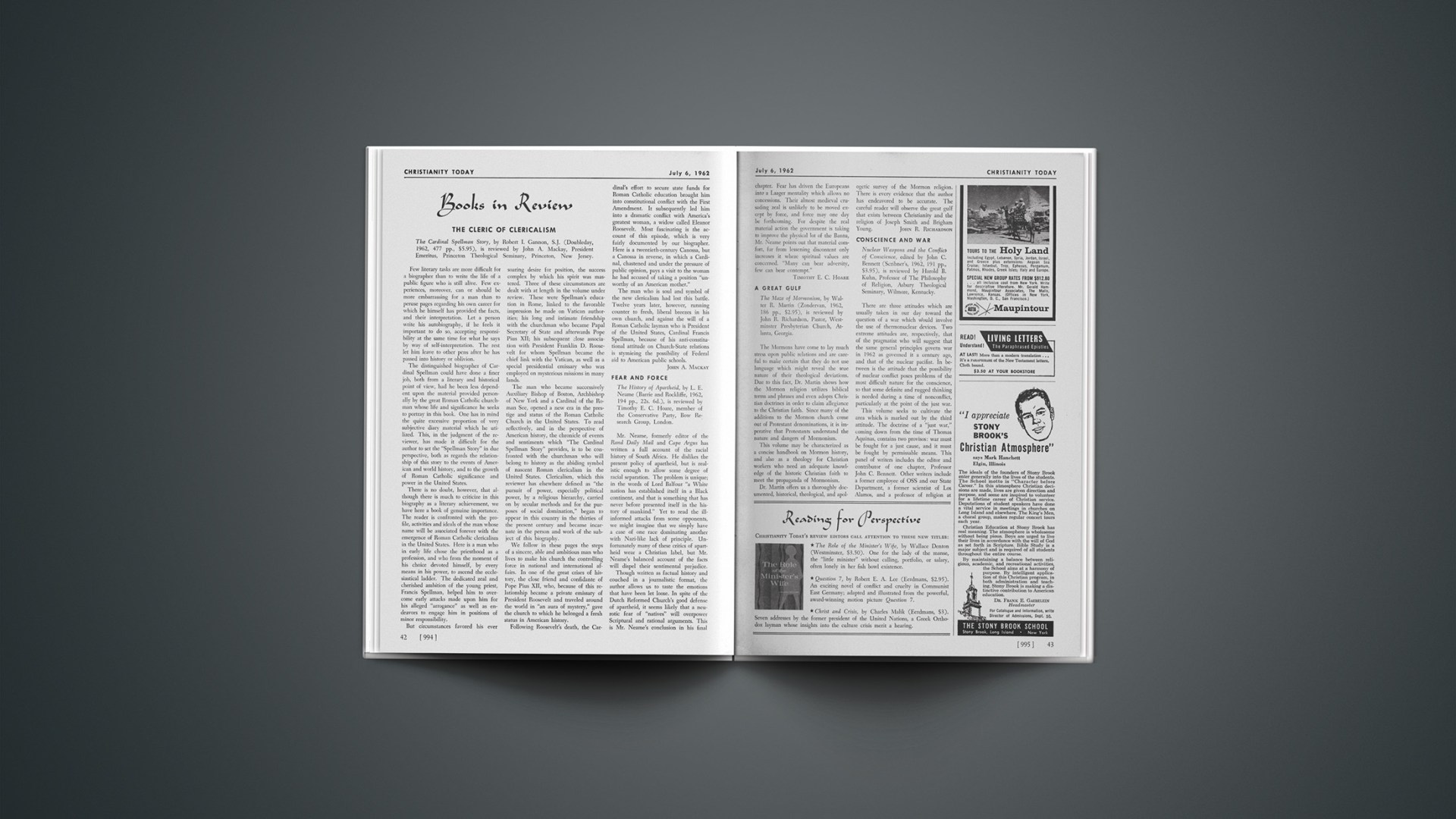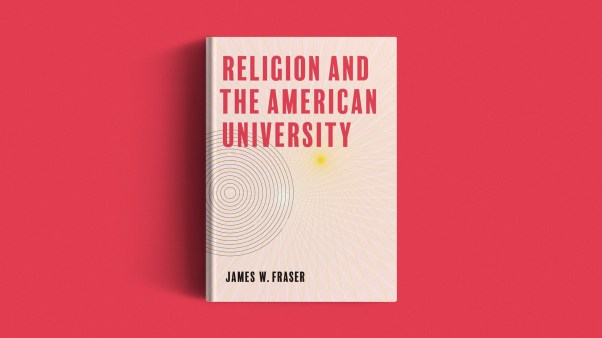The Cleric Of Clericalism
The Cardinal Spellman Story, by Robert I. Gannon, S.J. (Doubleday, 1962, 477 pp., $5.95), is reviewed by John A. Mackay, President Emeritus, Princeton Theological Seminary, Princeton, New Jersey.
Few literary tasks are more difficult for a biographer than to write the life of a public figure who is still alive. Few experiences, moreover, can or should be more embarrassing for a man than to peruse pages regarding his own career for which he himself has provided the facts, and their interpretation. Let a person write his autobiography, if he feels it important to do so, accepting responsibility at the same time for what he says by way of self-interpretation. The rest let him leave to other pens after he has passed into history or oblivion.
The distinguished biographer of Cardinal Spellman could have done a finer job, both from a literary and historical point of view, had he been less dependent upon the material provided personally by the great Roman Catholic churchman whose life and significance he seeks to portray in this book. One has in mind the quite excessive proportion of very subjective diary material which he utilized. This, in the judgment of the reviewer, has made it difficult for the author to set the “Spellman Story” in due perspective, both as regards the relationship of this story to the events of American and world history, and to the growth of Roman Catholic significance and power in the United States.
There is no doubt, however, that although there is much to criticize in this biography as a literary achievement, we have here a book of genuine importance. The reader is confronted with the profile, activities and ideals of the man whose name will be associated forever with the emergence of Roman Catholic clericalism in the United States. Here is a man who in early life chose the priesthood as a profession, and who from the moment of his choice devoted himself, by every means in his power, to ascend the ecclesiastical ladder. The dedicated zeal and cherished ambition of the young priest, Francis Spellman, helped him to overcome early attacks made upon him for his alleged “arrogance” as well as endeavors to engage him in positions of minor responsibility.
But circumstances favored his ever soaring desire for position, the success complex by which his spirit was mastered. Three of these circumstances are dealt with at length in the volume under review. These were Spellman’s education in Rome, linked to the favorable impression he made on Vatican authorities; his long and intimate friendship with the churchman who became Papal Secretary of State and afterwards Pope Pius XII; his subsequent close association with President Franklin D. Roosevelt for whom Spellman became the chief link with the Vatican, as well as a special presidential emissary who was employed on mysterious missions in many lands.
The man who became successively Auxiliary Bishop of Boston, Archbishop of New York and a Cardinal of the Roman See, opened a new era in the prestige and status of the Roman Catholic Church in the United States. To read reflectively, and in the perspective of American history, the chronicle of events and sentiments which “The Cardinal Spellman Story” provides, is to be confronted with the churchman who will belong to history as the abiding symbol of nascent Roman clericalism in the United States. Clericalism, which this reviewer has elsewhere defined as “the pursuit of power, especially political power, by a religious hierarchy, carried on by secular methods and for the purposes of social domination,” began to appear in this country in the thirties of the present century and became incarnate in the person and work of the subject of this biography.
We follow in these pages the steps of a sincere, able and ambitious man who lives to make his church the controlling force in national and international affairs. In one of the great crises of history, the close friend and confidante of Pope Pius XII, who, because of this relationship became a private emissary of President Roosevelt and traveled around the world in “an aura of mystery,” gave the church to which he belonged a fresh status in American history.
Following Roosevelt’s death, the Cardinal’s effort to secure state funds for Roman Catholic education brought him into constitutional conflict with the First Amendment. It subsequently led him into a dramatic conflict with America’s greatest woman, a widow called Eleanor Roosevelt. Most fascinating is the account of this episode, which is very fairly documented by our biographer. Here is a twentieth-century Canossa, but a Canossa in reverse, in which a Cardinal, chastened and under the pressure of public opinion, pays a visit to the woman he had accused of taking a position “unworthy of an American mother.”
The man who is soul and symbol of the new clericalism had lost this battle. Twelve years later, however, running counter to fresh, liberal breezes in his own church, and against the will of a Roman Catholic layman who is President of the United States, Cardinal Francis Spellman, because of his anti-constitutional attitude on Church-State relations is stymieing the possibility of Federal aid to American public schools.
JOHN A. MACKAY
Fear And Force
The History of Apartheid, by L. E. Neame (Barrie and Rockliffe, 1962, 194 pp., 22s. 6d.), is reviewed by Timothy E. C. Hoare, member of the Conservative Party, Bow Research Group, London.
Mr. Neame, formerly editor of the Rand Daily Mail and Cape Argus has written a full account of the racial history of South Africa. He dislikes the present policy of apartheid, but is realistic enough to allow some degree of racial separation. The problem is unique; in the words of Lord Balfour “a White nation has established itself in a Black continent, and that is something that has never before presented itself in the history of mankind.” Yet to read the ill-informed attacks from some opponents, we might imagine that we simply have a case of one race dominating another with Nazi-like lack of principle. Unfortunately many of these critics of apartheid wear a Christian label, but Mr. Neame’s balanced account of the facts will dispel their sentimental prejudice.
Though written as factual history and couched in a journalistic format, the author allows us to taste the emotions that have been let loose. In spite of the Dutch Reformed Church’s good defense of apartheid, it seems likely that a neurotic fear of “natives” will overpower Scriptural and rational arguments. This is Mr. Neame’s conclusion in his final chapter. Fear has driven the Europeans into a Laager mentality which allows no concessions. Their almost medieval crusading zeal is unlikely to be moved except by force, and force may one day he forthcoming. For despite the real material action the government is taking to improve the physical lot of the Bantu, Mr. Neame points out that material comfort, far from lessening discontent only increases it where spiritual values are concerned. “Many can bear adversity, few can bear contempt.”
TIMOTHY E. C. HOARE
A Great Gulf
The Maze of Mormonism, by Walter R. Martin (Zondervan, 1962, 186 pp., $2.95), is reviewed by John R. Richardson, Pastor, Westminster Presbyterian Church, Atlanta, Georgia.
The Mormons have come to lay much stress upon public relations and are careful to make certain that they do not use language which might reveal the true nature of their theological deviations. Due to this fact, Dr. Martin shows how the Mormon religion utilizes biblical terms and phrases and even adopts Christian doctrines in order to claim allegiance to the Christian faith. Since many of the additions to the Mormon church come out of Protestant denominations, it is imperative that Protestants understand the nature and dangers of Mormonism.
This volume may be characterized as a concise handbook on Mormon history, and also as a theology for Christian workers who need an adequate knowledge of the historic Christian faith to meet the propaganda of Mormonism.
Dr. Martin offers us a thoroughly documented, historical, theological, and apologetic survey of the Mormon religion. There is every evidence that the author has endeavored to be accurate. The careful reader will observe the great gulf that exists between Christianity and the religion of Joseph Smith and Brigham Young.
JOHN R. RICHARDSON
Reading for Perspective
CHRISTIANITY TODAY’S REVIEW EDITORS CALL ATTENTION TO THESE NEW TITLES:
* The Role of the Minister’s Wife, by Wallace Denton (Westminster, $3.50). One for the lady of the manse, the “little minister” without calling, portfolio, or salary, often lonely in her fish bowl existence.
* Question 7, by Robert E. A. Lee (Eerdmans, $2.95). An exciting novel of conflict and cruelty in Communist East Germany; adapted and illustrated from the powerful, award-winning motion picture Question 7.
* Christ and Crisis, by Charles Malik (Eerdmans, $3). Seven addresses by the former president of the United Nations, a Greek Orthodox layman whose insights into the culture crisis merit a hearing.
Conscience And War
Nuclear Weapons and the Conflict of Conscience, edited by John C. Bennett (Scribner’s, 1962, 191 pp., $3.95), is reviewed by Harold B. Kuhn, Professor of The Philosophy of Religion, Asbury Theological Seminary, Wilmore, Kentucky.
There are three attitudes which are usually taken in our day toward the question of a war which would involve the use of thermonuclear devices. Two extreme attitudes are, respectively, that of the pragmatist who will suggest that the same general principles govern war in 1962 as governed it a century ago, and that of the nuclear pacifist. In between is the attitude that the possibility of nuclear conflict poses problems of the most difficult nature for the conscience, so that some definite and rugged thinking is needed during a time of nonconflict, particularly at the point of the just war.
This volume seeks to cultivate the area which is marked out by the third attitude. The doctrine of a “just war,” coming down from the time of Thomas Aquinas, contains two provisos: war must be fought for a just cause, and it must be fought by permissable means. This panel of writers includes the editor and contributor of one chapter, Professor John C. Bennett. Other writers include a former employee of OSS and our State Department, a former scientist of Los Alamos, and a professor of religion at Princeton University. They seek to explore the moral implications of the possession of, the threatened use of, and an international policy based upon the existence of a supply of weapons which are basically genocidal.
The writers have few illusions concerning the attitude toward a possible nuclear conflict which the policy makers of the U.S.S.R. now take, and would take in the event they decide to launch an all-out war. Nor do they have any illusions concerning the degree to which moral scruples and considerations for truth would deter the men of the Kremlin if they felt they could win such a war.
Resumption of atmospheric tests of bombs up to 60 megatons of capability after the most solemn pledges that they would never be the first to do so has ended optimism concerning the idealism of the Red masters.
This volume does not profess to have final answers for our consciences. It does, however, raise questions which every sensitive Christian should ponder. The realism with which the capabilities of modern warfare should be regarded is spelled out in rugged detail. The work of this group of men deserves the most serious consideration of those who would try to think their way through the dilemma with which mankind’s new technological achievements confront it.
HAROLD B. KUHN
Rebel Against Reason?
Grace and Reason: A Study in the Theology of Luther, by B. A. Gerrish (Oxford University Press, 1962, 188 pp., $6.75 or 30s.), is reviewed by Paul M. Bretscher, Professor of New Testament, Concordia Seminary, St. Louis, Missouri.
Mr. Gerrish investigates the charge often leveled against Luther, that he was given to “irrationalism” and championed a revolt against reason. On the strength of much evidence from Luther’s writings, the author concludes that to understand Luther’s attitude toward reason one must bear in mind that Luther distinguishes between “1. natural reason ruling within its own proper domain in worldly matters (a ‘practical reason’ approaching at times the notion of ‘common sense’); 2. natural reason illegitimately carrying over into the domain of spiritual matters certain presuppositions derived from ‘the world’; 3. regenerate reason working legitimately within the domain of spiritual matters by humbly adopting presuppositions derived solely from ‘the Word’ ” (p. 170). The author also reminds us that Luther’s profound appreciation of the sola gratia compelled him to expose and reject every form of opinio legis (within and outside the church) which sought status before God alongside of gratia.
The author states his findings with persuasive forthrightness and cautious restraint. As a result of his magnificent achievement there is now available in the English tongue a thorough and comprehensive analysis of the meaning of ratio in Luther’s theology. The author’s study ought also to prove an exemplary guide for the investigation of other problems in Luther’s thought. We encourage the reader: Tolle et lege, and do not shy away from the copious but always exciting footnotes.
PAUL M. BRETSCHER
Entertaining Diversion
Hear the Word! A Novel about Elijah and Elisha, by Heinrich Zador, translated by Robert W. Fenn (S.C.M., 1962, 286 pp., 21s.; McGraw-Hill, $4.95), is reviewed by Calvin D. Linton, Professor of English Literature and Dean of Columbian College, George Washington University, Washington, D. C.
It is astonishingly difficult, seemingly, to write a really good novel on biblical subjects. Heinrich Zador has come commendably close, and in the process has written an interesting narrative, filled with three-dimensional characters and set in a land Mr. Zador knows at first hand (he has been a resident of Israel since 1939). But there is still the palpable difference (at least to one familiar with the Bible itself) between the matchless compression and dramatic power of the Old Testament stories in the King James Version, and the very best expanded, fictional account in modern English. Mr. Zador, indeed, suffers from a double handicap, since his novel was written in German (Die Erfüllung), and one cannot tell whether the translator has communicated the original quality.
To deal properly with titans like Elijah and Elisha obviously takes something close to epic style. They cannot be made familiar without being reduced in stature. Further to divest them of their miracles is to leave them looking like rather impressive but not awesome leaders of a modern California religious cult. As to the miracles, Mr. Zador is quite clear: “Gradually fantasy, desire and wish fulfillment crept into the stories … until the eventual form of the story was accepted as true, for that is how it ought to have happened.” Stature is lost, too, by such dialogue as that spoken when Elijah puts his robe on Elisha: “No! Do not make fun of me!” says Elisha. “I am not making fun,” replies Elijah. One yearns for the KJV.
The best part of the book ignores the prophets and concentrates on kings and princes, battles and alarms, court color and intrigue. Indeed, it might have been better to write a piece of historical fiction quite independently of the biblical narratives. Thus at least the awkwardness of the invented romance between Elisha and the Shunammite woman could have been avoided.
Despite these strictures, the novel is an entertaining diversion. It has pace, descriptive power, and unity. But it does not tell much about the real Elijah and Elisha.
CALVIN D. LINTON
Barth, Dooyeweerd, Runia
Karl Barth’s Doctrine of Holy Scripture, by Klaas Runia (Eerdmans, 1962, 225 pp., $4), is reviewed by Gordon H. Clark, Professor of Philosophy, Butler University, Indianapolis, Indiana.
This well-documented study with its valuable footnotes handles both exposition and criticism with easy clarity.
After explaining Barth’s view that the Bible is a witness to revelation but is not to be identified with revelation, the author goes to some length in showing that Barth accepts New Testament support for half his view but furnishes no New Testament evidence for the other half. In particular Dr. Runia points out that the biblical term witness and the Barthian term witness do not mean the same thing.
Again, in analyzing the concept saga, Dr. Runia uncovers the inconsistency between Barth’s expressed reliance on Scripture and his actual use of preconceived notions of what revelation must be. As before, the author shows that Barth pays no attention to what the Bible says about itself.
With respect to the charge that the Bible teaches ancient and outmoded world views, a charge for which Bultmann is better known than Barth, the author rejects the solution of Aalders and Grosheide that the Old Testament writers merely used everyday language to describe what they saw, and substitutes Dooyeweerd’s theory of law-spheres. Inasmuch as Dooyeweerd agrees with Barth in denying the inerrancy of Scripture, the precise intent of this substitution is hard to discern; and the later preference for plenary rather than verbalinspiration, as well as the apparent approval of John Mackay’s distinction between intellectual truth and “personal truth,” detract from the otherwise firm defense of biblical authority.
For a conclusion, and in opposition to those who say that Barth has changed his views, the author with adequate documentation shows that Barth has not changed in any important way with reference to revelation and the Scripture. And the recent lectures in Chicago confirm Dr. Runia’s conclusion.
GORDON H. CLARK
Grey Flannel For You
Telling the Good News: A Public Relations Handbook for Churches, by various authors (Concordia Publishing House, 1962, 202 pp., $2.50), is reviewed by Bruce A. Brough, Editorial Assistant, CHRISTIANITY TODAY.
Here is a collection of useful information in the vital (and neglected) field of church public relations. Although the term “public relations” conjures up mental images of a smooth, sophisticated pitchman in the proverbial grey flannel suit, this little handbook brings things back into perspective.
How about such things as the condition of the church lawn? On the local level, such a “minor” point may have more effect on the public’s impression of your church than a well-designed church advertisement or a clever news release.
These items as well as the pastor’s personal public relations, hints on meeting misfortune, presenting the Gospel via radio, television and other media, and many other important points are thoroughly yet briefly covered. The writers are individuals well qualified in their respective fields of communication.
Difficult technical points are adequately discussed in each chapter, giving the pastor a working knowledge of any media he chooses to engage as he and his church seek to communicate, with utmost effectiveness, the best news of all time.
BRUCE A. BROUGH
Vatican Agenda
The Second Vatican Council, by Henri Daniel-Rops, translated by Alastair Guinan (Hawthorn Books, 1962, 160 pp., $3.50) is reviewed by W. Stanford Reid, Professor of History, McGill University, Montreal, Canada.
In this relatively short work Mr. Daniel-Rops, who has made a considerable name for himself as a lay historian and apologist for the Roman Catholic Church, endeavors to give something of the background of Pope John XXIII’s forthcoming ecumenical council. The first part of the work discusses the history of (Roman Catholic) ecumenical councils down to the present day. The second part endeavors to analyze and define the nature and operation of an ecumenical council, and the third part deals specifically with that called by the present pope.
The author points out that, although most of the interest in the council outside the Church of Rome has arisen from the Pope’s ecumenical emphasis, much more is involved. There will be discussions on the whole problem of the Roman church’s life and work. While the tone of the book is very irenical, as one reads one soon becomes aware that Roman Catholic claims still remain the same, and that any church union will be an absorption into the Roman ecclesiastical organization.
W. STANFORD REID
Book Briefs
God in Modern Philosophy, by James Collins (Henry Regnery Company, 1959, 476 pp., $6.50). A Thomistic philosopher’s analysis and evaluation of agreements and disagreements among modern thinkers (from Nicholas of Cues through Heidegger and Whitehead) about the nature of God.
Neo-evangelicalism, by Robert Lightner (Dunham, 1962, 170 pp., $2). An evaluation of so-called neo-evangelicalism by the extreme right with conclusions that are valid upon its own premises.
Alcoholism and Society, by Morris E. Chafetz, M.D., and Harold W. Demone, Jr. (Oxford, 1962, 319 pp., $6.95). Authors reject all single factor explanations of the cause of alcoholism. They deny that morality has anything to do with it, and suggest that cause stems from a complex of psycho-physiological and socio-cultural disturbances.
The Audacity of Preaching, by Gene E. Bartlett (Harper, 1962, 159 pp., $3). An animated discussion of the task of preaching which is pleasant to read. Perceptive in what it treats; rendered superficial by what it omits. The Lyman Beecher lectures.
Guilt and Grace, by Paul Tournier (Harper, 1962, 224 pp., $3.75). A competent treatment by a physician who bores into the phenomena of guilt in the light of God’s grace.
The Silence of God, by Helmut Thielicke (Eerdmans, 1962, 92 pp., $2.50). Sermonettes with an existential slant; solid and somber, throwing light on the dark places of the agonies of our age.
The Glories of the Cross, by A. C. Dixon (Eerdmans, 1962, 253 pp., $3). Distillations of the riches of the Gospel by an outstanding preacher of the early twentieth century.
The Sole Sufficiency of Jesus Christ, by Herbert W. Cragg (Revell, 1961, 110 pp., $2.50; Marshall, Morgan & Scott, 10s. 6d.). Brief to sketchy comments on the Epistle to the Colossians.
Christ in You, by Herschel H. Hobbs (Baker, 1961, 128 pp., $2.50). Popular exposition of Colossians; first fruit of Evangelical Pulpit Library.
Holding Fast to Grace, by Roy L. Aldrich (Dunham, 1962, 94 pp., $2). A book about Law under a title about Grace.
In the Beginning: A Journey Through Genesis, by Jack Finegan (Harper, 1962, 159 pp., $3.50). Conversational, scholarly, informative.
Aristotle Dictionary, ed. by Thomas P. Kiernan (Philosophical Library, 1962, 524 pp., $7.50). Definitions of Aristotle’s basic terms as distilled from his writings; with a 155-page introduction to his writings.
The Epistles of John, by Neil Alexander (SCM, 1962, 173 pp., 12s. 6d). A simple commentary, generally along traditional lines of interpretation, useful for the nonspecialist. The author is a lecturer at Aberdeen University, and believes the New Testament is not artistic in purpose, but evangelical and hortatory.
The Royal Psalms, by Keith R. Crim (John Knox, 1962, 127 pp., $2.75). Introduces Americans to the German and Scandinavian research on the Messianic Psalms. Preceded by a discussion of the kingship idea in Israel. A valuable study.
Paperbacks
The World He Loves, by Douglas W. Thompson (Edinburgh House Press, 1962, 112 pp., 5s.). This is a presentation of the challenge of the World Missionary situation by a much traveled Methodist missionary statesman.
Tillich, by David H. Freeman (Baker, 1962, 42 pp., $1.25). Author concludes that Tillich’s thought is generally “unintelligible,” a “theological square-circle,” and “nonsense.”
The Shape of Faith, by G. Hugh Wamble (Broadman, 1962, 88 pp., $1). Brief historical sketches of the shape the Christian faith has taken in seven denominations: Presbyterian, strict authority; Baptist, Christian fellowship; Lutheran, pure doctrine; Episcopal, formal worship, and so on.
Call To a Divided City, by Otto Dibelius (Kreuz Verlag, Stuttgart, Germany, 1961, 66 pp., $.75). Addresses delivered by the bishop of Berlin to his severed diocese immediately after the erection of the Berlin wall.
Collectivism Challenges Christianity, by Verne Paul Kaub (Light and Life, 1961, 249 pp., $1). A cry for freedom against the encroachments of collectivism. First published in 1946.
The Rites of Christian Initiation, by C. E. Pocknee (Mowbrays, 1962, 46 pp., 6s.). A tendentious High Episcopalian case exalting confirmation at the expense of baptism; originally lectures at Seabury Seminary.
The Speeches of Peter in the Acts of the Apostles, by H. N. Ridderbos (Tyndale, 1962, 31 pp., 1s. 6d.). Originally the 1961 Tyndale New Testament lecture by a learned Dutch scholar.
Cities and Churches, ed. by Robert Lee (Westminster, 1962, 366 pp., $3.50). A comprehensive study of the multiple problems of the inner-city church created by the mass movement to suburbia.
The Atonement, by John Murray (Presbyterian and Reformed, 1962, 31 pp., $.75). Competent explication of the Atonement as a substitutionary act.
Election and Reprobation, by James Henly Thornwell (Presbyterian and Reformed, 1961, 97 pp., $1.50). Monograph on election and reprobation according to the Westminster Confession; first published in 1840 and republished on the occasion of the Centennial of Presbyterian Church, U.S.
Limited Inspiration, by Benjamin B. Warfield (Presbyterian and Reformed, 1962, 54 pp., $1.25). Originally published in 1894 under title Professor Henry Preserved Smith, on Inspiration.
Thoughts on the Prayer Book, by J. C. Ryle (Church Book Room Press, 1962, 15 pp., 9d.). Another paperback reprint by a nineteenth-century evangelical bishop.
The Narratives of the Passion, by the Archbishop of Canterbury (Mowbrays, 1962, 26 pp., 3s.). A lecture delivered to the International New Testament Congress at Oxford in 1961 stressing the different aspects of the Passion in each Gospel.
Barth’s Christology, by Cornelius Van Til (Presbyterian and Reformed, 1962, 29 pp., $.75). Author argues to conclusion that Barth’s Christ is a “meaningless mirage” and his theology a philosophy of “egress and regress.…”
Baptism Not For Infants, by T. E. Watson (obtainable from author: Ribchester, Lancashire, England; 1962, 108 pp., 3s. 6d.). A strict Baptist attack on Paedobaptism, but without reference to most modern works.
German-English Theological Word List, Revised Edition, by Carl Bangs (Carl Bangs, 5110 Cherry, Kansas City 10, Mo.; 1962, 16 pp., $1). Good for German reader who needs help with theological and philosophical terminology.










